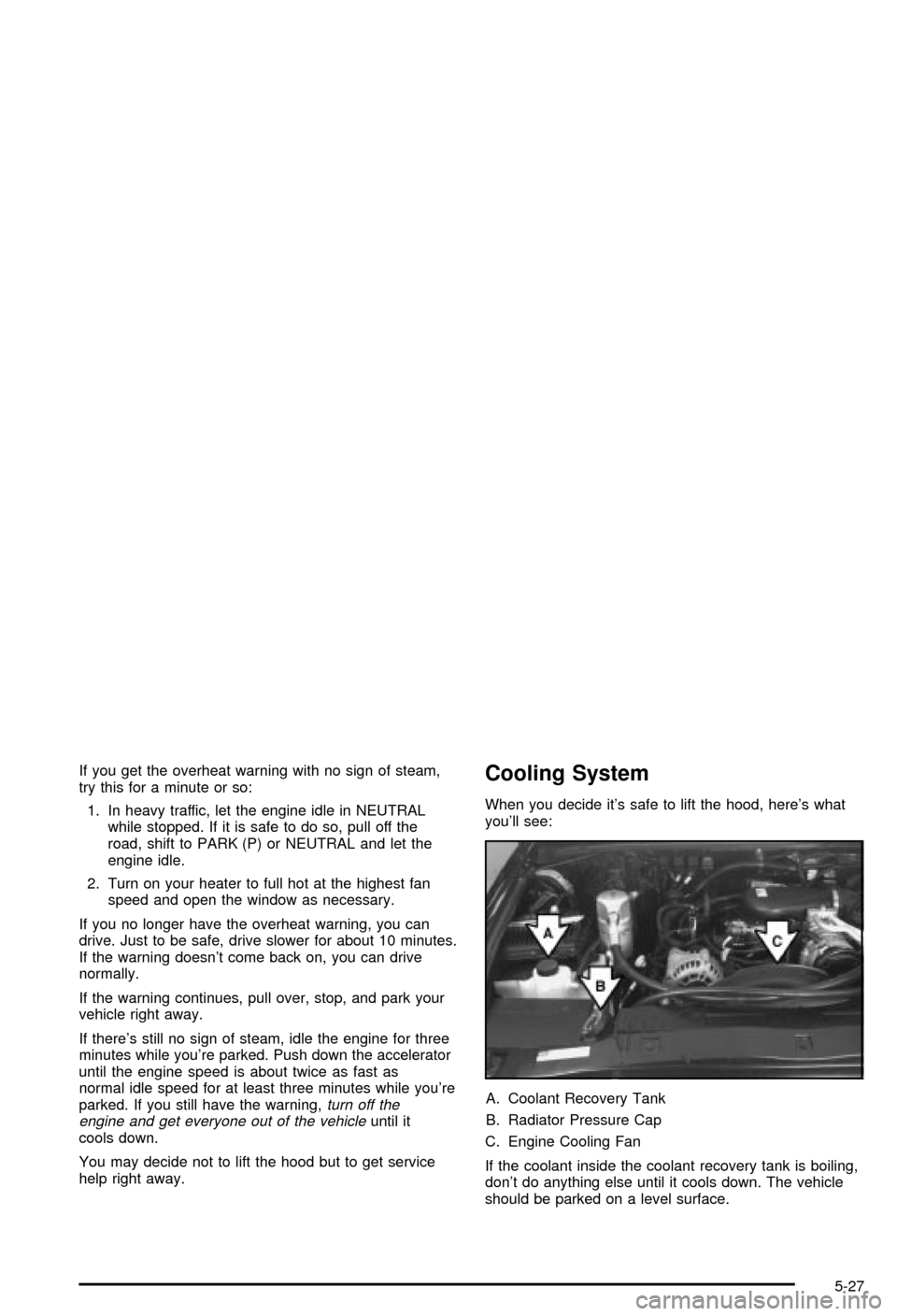2003 CHEVROLET BLAZER window
[x] Cancel search: windowPage 291 of 420

If you get the overheat warning with no sign of steam,
try this for a minute or so:
1. In heavy traffic, let the engine idle in NEUTRAL
while stopped. If it is safe to do so, pull off the
road, shift to PARK (P) or NEUTRAL and let the
engine idle.
2. Turn on your heater to full hot at the highest fan
speed and open the window as necessary.
If you no longer have the overheat warning, you can
drive. Just to be safe, drive slower for about 10 minutes.
If the warning doesn't come back on, you can drive
normally.
If the warning continues, pull over, stop, and park your
vehicle right away.
If there's still no sign of steam, idle the engine for three
minutes while you're parked. Push down the accelerator
until the engine speed is about twice as fast as
normal idle speed for at least three minutes while you're
parked. If you still have the warning,
turn off the
engine and get everyone out of the vehicleuntil it
cools down.
You may decide not to lift the hood but to get service
help right away.
Cooling System
When you decide it's safe to lift the hood, here's what
you'll see:
A. Coolant Recovery Tank
B. Radiator Pressure Cap
C. Engine Cooling Fan
If the coolant inside the coolant recovery tank is boiling,
don't do anything else until it cools down. The vehicle
should be parked on a level surface.
5-27
Page 340 of 420

Spare Tire
Your vehicle, when new, had a fully in¯ated spare tire.
A spare tire, whether compact±size or full±size, may
lose air over time, so check its in¯ation pressure
regularly. See
In¯ation -- Tire Pressure on page 5-55andLoading Your Vehicle on page 4-52for information
regarding proper tire in¯ation and loading your
vehicle. For instruction on how to remove, install or
store a spare tire, see
Changing a Flat Tire on
page 5-63.
After installing the spare tire on your vehicle, you should
stop as soon as possible and make sure the spare is
correctly in¯ated. Have the damaged or ¯at road
tire repaired or replaced as soon as you can and
installed back onto your vehicle. This way, a spare tire
will be available in case you need it again.
Don't mix tires and wheels of different sizes, because
they won't ®t. Keep your spare tire and its wheel
together.
If your vehicle has the XtremeŸ Sport Appearance
Package (RPO V4A), the spare tire is smaller than your
vehicle's original road tires, so don't include the spare
in the tire rotation.
Appearance Care
Remember, cleaning products can be hazardous. Some
are toxic. Others can burst into ¯ames if you strike a
match or get them on a hot part of the vehicle. Some are
dangerous if you breathe their fumes in a closed
space. When you use anything from a container to clean
your vehicle, be sure to follow the manufacturer's
warnings and instructions. And always open your doors
or windows when you're cleaning the inside.
Neveruse these to clean your vehicle:
·Gasoline
·Benzene
·Naphtha
·Carbon Tetrachloride
·Acetone
·Paint Thinner
·Turpentine
·Lacquer Thinner
·Nail Polish Remover
They can all be hazardous ± some more than
others ± and they can all damage your vehicle, too.
5-76
Page 342 of 420

Cleaning the Top of the Instrument
Panel
Use only mild soap and water to clean the top surfaces
of the instrument panel. Sprays containing silicones
or waxes may cause annoying re¯ections in the
windshield and even make it difficult to see through the
windshield under certain conditions.
Cleaning Interior Plastic Components
Use only a mild soap and water solution on a soft cloth
or sponge. Commercial cleaners may affect the
surface ®nish.
Cleaning Wood Panels
Use a clean cloth moistened in warm, soapy water (use
mild dish washing soap). Dry the wood immediately
with a clean cloth.
Cleaning Glass Surfaces
Glass should be cleaned often. GM Glass Cleaner or a
liquid household glass cleaner will remove normal
tobacco smoke and dust ®lms on interior glass. See
Vehicle Care/Appearance Materials on page 5-82.
Notice:Don't use abrasive cleaners on glass,
because they may cause scratches. Avoid placing
decals on the inside rear window, since they
may have to be scraped off later. If abrasive cleaners
are used on the inside of the rear window, an
electric defogger element may be damaged. Any
temporary license should not be attached across the
defogger grid.
Care of Safety Belts
Keep belts clean and dry.
{CAUTION:
Do not bleach or dye safety belts. If you do, it
may severely weaken them. In a crash, they
might not be able to provide adequate
protection. Clean safety belts only with mild
soap and lukewarm water.
5-78
Page 349 of 420

Windshield Wiper Fuses
The windshield wiper motor is protected by a circuit
breaker and a fuse. If the motor overheats due to heavy
snow or ice, the wiper will stop until the motor cools.
If the overload is caused by some electrical problem, be
sure to get it ®xed.
Power Windows and Other Power
Options
Circuit breakers protect the power windows and other
power accessories. When the current load is too heavy,
the circuit breaker opens and closes, protecting the
circuit until the problem is ®xed or goes away.
Fuses and Circuit Breakers
The wiring circuits in your vehicle are protected from
short circuits by a combination of fuses and circuit
breakers. This greatly reduces the chance of ®res
caused by electrical problems.
Look at the silver-colored band inside the fuse. If the
band is broken or melted, replace the fuse. Be sure you
replace a bad fuse with a new one of the identical
size and rating.
If you ever have a problem on the road and don't have
a spare fuse, you can borrow one that has the same
amperage. Just pick some feature of your vehicle
that you can get along withoutÐ like the radio or
cigarette lighterÐand use its fuse, if it is the correct
amperage. Replace it as soon as you can.
5-85
Page 351 of 420

Fuse Usage
4 Gages, Body Control Module,
Instrument Panel Cluster
5 Parking Lamps, Power Window
Switch, Body Control Module,
Ashtray Lamp
6 Steering Wheel Radio Controls
7 Headlamps Switch, Body Control
Module, Headlamp Relay
8 Courtesy Lamps, Battery Run-Down
Protection
9 Heating, Ventilation, Air Cooling
Control Head (Manual)
10 Turn Signal
11 Cluster, Engine Control Module
12 Interior Lights
13 Auxiliary Power
14 Power Locks MotorFuse Usage
15 4WD Switch, Engine Controls (VCM,
PCM, Transmission)
16 Supplemental In¯atable Restraint
17 Front Wiper
18 Steering Wheel Radio Controls
19 Radio, Battery
20 Ampli®er
21 Heating, Ventilation, Air Cooling
(Manual), Heating,Ventilation, Air
Cooling (Automatic), Heating,
Ventilation, Air Cooling Sensors
(Automatic)
22 Anti-Lock Brakes
23 Rear Wiper
24 Radio, Ignition
5-87
Page 354 of 420

Fuse Usage
PARKLP Parking Lamps
LR PRK Left Rear Parking Lamps
LIFTGLASS Liftglass
IGN C Starter Solenoid, Fuel Pump,
PRNDL
HTDSEAT Heated Seat
HVAC Heating,Ventilation, Air Cooling
System
TRCHMSL Trailer Center High Mount Stop Light
RRDFOG Rear Defogger
TBC Truck Body ComputerFuse Usage
CRANK Clutch Switch, NSBU Switch
CHMSL Center High Mounted Stoplamp
HAZLP Hazard Lamps
VECHMSL Vehicle Center High-Mounted Stop
Lamp
RR DEFOG Rear Defogger
HTDMIR Heated Mirror
ATC Transfer Case (Four-Wheel Drive)
STOPLP Stop Lamps
RR W/W Rear Window Wiper
5-90
Page 409 of 420

Driving On Grades..........................................4-62
Driving on Off-Road Hills.................................4-19
Driving on Snow or Ice....................................4-38
Driving Through Deep Standing Water...............4-32
Driving Through Flowing Water.........................4-32
Driving Uphill..................................................4-20
Driving with a Trailer.......................................4-60
Driving..........................................................4-28
At Night.....................................................4-28
City...........................................................4-33
Defensive..................................................... 4-3
Drunken....................................................... 4-4
Environment................................................. 4-3
Freeway.....................................................4-34
Hill and Mountain Roads..............................4-36
In Rain and on Wet Roads...........................4-30
Winter........................................................4-38
E
Electrical System............................................5-84
Add-On Equipment......................................5-84
Fuses and Circuit Breakers...........................5-85
Headlamps.................................................5-84
Power Windows and Other Power Options......5-85
Windshield Wiper Fuses...............................5-85
Electronic Transfer Case..................................2-29
Emergency Release for Opening Tailgate...........2-15Emissions Inspection and Maintenance
Programs...................................................3-32
Engine Compartment Fuse Block......................5-88
Engine Coolant Level Check.............................6-26
Engine Oil Additives........................................5-14
Engine Oil Level Check...................................6-26
Engine..........................................................5-15
Air Cleaner/Filter.........................................5-15
Battery.......................................................5-40
Check and Service Engine Soon Light............3-30
Compartment Overview................................5-10
Coolant Heater............................................2-22
Coolant Temperature Gage...........................3-29
Coolant......................................................5-22
Cooling System Inspection............................6-31
Exhaust.....................................................2-39
Fan Noise..................................................5-34
Oil .............................................................5-11
Overheating................................................5-25
Starting......................................................2-21
Entry Lighting.................................................3-14
Environmental Concerns..................................4-17
Erasing HomeLink
žButtons..............................2-47
Exit Lighting...................................................3-14
Express Down Window....................................2-12
Extender, Safety Belt.......................................1-31
Exterior Lamps...............................................3-11
5
Page 415 of 420

P
Park (P)........................................................2-35
Shifting Into................................................2-35
Shifting Out of............................................2-37
Parking Brake and Automatic Transmission
Park (P) Mechanism Check...........................6-30
Parking on Hills..............................................4-63
Parking Your Vehicle.......................................2-38
Parking.........................................................2-34
Brake........................................................2-34
Over Things That Burn.................................2-38
Part A - Scheduled Maintenance Services............ 6-4
Part B - Owner Checks and Services................6-26
Part C - Periodic MaintenanceInspections..........6-31
Part D - Recommended Fluids and Lubricants....6-33
Part E - Maintenance Record...........................6-35
Passing.................................................4-13, 4-61
Passlock
ž......................................................2-18
Payload.........................................................4-54
Plan Ahead When Possible................................ 7-8
Playing a Cassette Tape..................................3-53
Playing a Compact Disc..................3-46, 3-55, 3-63
Playing a Speci®c Loaded
Compact Disc.............................................3-64
Playing the Radio...................3-38, 3-41, 3-48, 3-58
Power Steering...............................................4-10
Power...........................................................3-15
Accessory Outlets........................................3-15
Door Locks.................................................. 2-8Power (cont.)
Electrical System.........................................5-85
Lumbar Controls........................................... 1-4
Seat............................................................ 1-3
Steering Fluid.............................................5-35
Windows....................................................2-12
Programmable Automatic Door Locks.................. 2-8
Programming the HomeLink Transmitter.............2-45
Q
Questions and Answers About Safety Belts.........1-13
R
Radiator Pressure Cap....................................5-25
Radio Messages.............................3-40, 3-45, 3-53
Radios..........................................................3-37
AM-FM Radio.............................................3-38
Care of Your Cassette Tape Player................3-69
Care of Your CD Player...............................3-70
Care of Your CDs........................................3-70
Radio with Cassette and CD.........................3-48
Radio with CD............................................3-41
Radio with Six-Disc CD................................3-58
Setting the Time for Radios with Radio Data
Systems (RDS)........................................3-38
Setting the Time for Radios without Radio
Data Systems (RDS)................................3-37
11